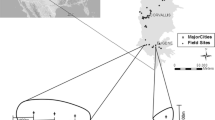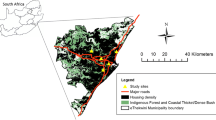Abstract
We examine the influence of both local habitat and landscape variables on avian species abundance at forested study sites situated within fragmented and contiguous landscapes. The study was conducted over a six year period (1991–1996) at 10 study sites equally divided between the heavily forested Missouri Ozarks and forest fragments in central Missouri. We found greater species richness and diversity in the fragments, but there was a higher percentage of Neotropical migrants in the Ozarks. We found significant differences in the mean number of birds detected between the central Missouri fragments and the unfragmented Ozarks for 15 (63%) of 24 focal species. We used stepwise regression to determine which of 12 local vegetation variables and 4 landscape variables (forest cover, core area, edge density, and mean patch size) accounted for the greatest amount of variation in abundance for 24 bird species. Seven species (29%) were most sensitive to local vegetation variables, while 16 species (67%) responded most strongly to one of four landscape variables. Landscape variables are significant predictors of abundance for many bird species; resource managers should consider multiple measures of landscape sensitivity when making bird population management decisions.
Similar content being viewed by others
References
Blenden, M.D., Armbruster, M.J., Baskett, T.S. and Farmer, A.H. 1986. Evaluation of model assumptions: the relationship between plant biomass and arthropod abundance. In Wildlife 2000: modeling habitat relationships of terrestrial vertebrates. Pp. 11–14. Edited by Verner, J., Morrison, M.L. and Ralph, C.J. University of Wisconsin Press, Madison.
Bolger, D.T., Scott, T.A. and Rotenberry, J.T. 1997. Breeding bird abundance in an urbanizing landscape in coastal southern California. Cons. Biol. 11: 406–421.
Brawn, J.D. and Robinson, S.K. 1996. Source-sink population dynamics may complicate the interpretation of long-term census data. Ecology 77: 3–12.
Burke, D.M. and Nol, E. 1998. Influence of food abundance, nestsite habitat, and forest fragmentation on breeding Ovenbirds. Auk 115: 96–104.
Cody, M.L. 1985. Habitat selection in birds. Academic Press, Orlando, Florida.
Donovan, T.M. 1994. The demography of Neotropical migrant birds in habitat sources and sinks. Ph.D. dissertation. University of Missouri, Columbia.
Donovan, T.M., Thompson III, F.R., Faaborg, J. and Probst, J.R. 1995a. Reproductive success of migratory birds in habitat sources and sinks. Cons. Biol. 9: 1380–1395.
Donovan, T.M., Lamberson, R.H., Kimber, A., Thompson III, F.R. and Faaborg, J. 1995b. Modeling the effects of habitat fragmentation on source and sink demography of Neotropical migrant birds. Cons. Biol. 9: 1396–1407.
Donovan, T.M., Jones, P.W., Annand, E.M. and Thompson III, F.R. 1997. Variation in local scale edge effects: mechanisms and landscape context. Ecology 78: 2064–2075.
Donovan, T.M., Thompson III, F.R. and Faaborg, J. 1999. Cowbird distribution at different scales of fragmentation: tradeoffs between breeding and feeding opportunities. In The ecology and management of cowbirds. Edited by Cooke, T.L., Robinson, S.K., Rothstein, S.I., Sealy, S.G. and Smith, J.N.M. University of Texas Press, Austin, Texas, USA.
Faaborg, J. 1980. Potential uses and abuses of diversity concepts in wildlife management. Trans. Missouri Acad. Sci. 14: 41–49.
Faaborg, J., Brittingham, M., Donovan, T. and Blake, J. 1995. Habitat fragmentation in the temperate zone. In Ecology and management of Neotropical migratory birds. Pp. 357–380. Edited by Martin, T. and Finch, D. Oxford University Press, New York.
Fish and Wildlife Service. 1980. Habitat evaluation procedures (HEP). Ecological Services Manual 102. U.S. Department of Interior, Fish and Wildlife Service, Division of Ecological Services, Washington, D.C.
Flather, C.H. and Sauer, J.R. 1996. Using landscape ecology to test hypotheses about large-scale abundance patterns in migratory birds. Ecology 77: 28–35.
Forman, R.T.T. and Godron, M. 1986. Landscape ecology. J. Wiley & Sons, New York.
Freemark, K.E., Dunning, J.B., Hejl, S.J. and Probst, J.R. 1995. A landscape ecology perspective for research, conservation, and management. In Ecology and management of Neotropical migratory birds. Pp. 381–427. Edited by Martin, T. and Finch, D. Oxford University Press, New York.
Gibbs, J.P. and Faaborg, J. 1990. Estimating the viability of Ovenbird and Kentucky Warbler populations in forest fragments. Cons. Biol. 4: 193–196.
Haggerty, T.M. and E.S. Morton. 1995. Carolina Wren (Thryothorus ludovicianus). In The Birds of North America, No. 188. Edited by Poole, A. and Gill, F. The Academy of Natural Sciences, Philadelphia, PA, and The American Ornithologists' Union, Washington, D.C.
Hoover, J.P. and Brittingham, M.C. 1998. Nest-site selection and nesting success of Wood Thrushes. Wilson Bull. 110: 375–383.
Hunter, M.L. 1990. Wildlife, forests, and forestry: principles of managing forests for biological diversity. Prentice-Hall, Englewood Cliffs, New Jersey.
Jacobs, B. and Wilson, J.D. 1997. Missouri breeding bird atlas, 1986–1992. Missouri Dept. of Conservation.
James, F.C., Wiedenfeld, D.A. and McCulloch, C.E. 1992. Trends in breeding populations of warblers: Declines in the southern highlands and increases in the lowlands. In Ecology and conservation of Neotropical migrant landbirds. Pp. 43–56. Edited by Hagan III, J.M. and Johnston, D.W. Smithsonian Institution Press, Washington, D. C.
James, F.C., McCulloch, C.E. and Wiedenfeld, D.A. 1996. New approaches to the analysis of population trends in land birds. Ecology 77: 13–27.
Kabrick, J.M., Larsen, D.R. and Shifley, S.R. 1997. Analysis of pre-treatment woody vegetation and environmental data for the Missouri Ozark Forest Ecosystem Project. In Proceedings of the Missouri Ozark Forest Ecosystem Project Symposium: An experimental approach to landscape research. Pp. 150–168. Edited by Brookshire, B.L. and Shifley, S.R. USDA Forest Service, Gen. Tech. Report NC 193.
Kessler, W.B., Salwasser, H., Cartwright, Jr., C.W. and Caplan, J.A. 1992. New perspectives for sustainable natural resources management. Ecol. Appl. 2: 221–225.
Liu, J., Dunning, J.B. and Pulliam, H.R. 1995. Potential effects of a forest management plan on Bachman's Sparrows (Aimophila aestivalis): linking a spatially explicit model with GIS. Cons. Biol. 9: 62–75.
MacArthur, R.H. and Wilson, E.O. 1967. The theory of island biogeography. Princeton University Press, Princeton, New Jersey.
Montana Cooperative Wildlife Research Unit (MCWRU). 1994. BBIRD Protocol. Missoula, Montana.
Morrison, M.L., Marcot, B.G. and Mannan, R.W. 1992. Wildlifehabitat relationships: concepts and applications. University of Wisconsin Press, Madison.
Murphy, D.D. and Wilcox, B.A. 1986. Butterfly diversity in natural habitat fragments: a test of the validity of vertebrate-based management. In Wildlife 2000: modeling habitat relationships of terrestrial vertebrates. Pp. 287–292. Edited by Verner, J., Morrison, M.L. and Ralph, C.J. University of Wisconsin Press, Madison.
Noss, R.F. 1983. A regional landscape approach to maintain biodiversity. Bioscience 33: 700–706.
Paton, P.W.C. 1994. The effect of edge on avian nest success: How strong is the evidence? Cons. Biol. 8: 17–26.
Porneluzi, P.A. and Faaborg, J. 1999. Season-long fecundity, survival, and viability of Ovenbirds in fragmented and unfragmented landscapes. Cons. Biol. 13: 1151–1161.
Pulliam, H.R. 1988. Sources, sinks, and population regulation. Am. Nat. 132: 652–661.
Renjifo, L.M. 1999. Composition changes in a subandean avifauna after long-term forest fragmentation. Cons. Biol. 13: 1124–1139.
Robbins, C.S., Dawson, D.K. and Dowell, B.A. 1989. Habitat area requirements of breeding birds of the Middle Atlantic States. Wildlife Monog. 103: 1–34.
Robinson, S.K., Thompson III, F.R., Donovan, T.M., Whitehead, D.R. and Faaborg, J. 1995. Regional forest fragmentation and the nesting success of migratory birds. Science 267: 1987–1990.
Rosenthal, R. and Rosnow, R.L. 1985. Contrast analysis: Focused comparisons in the analysis of variance. Cambridge University Press, Cambridge.
SAS Institute Inc. 1990. SAS User's guide: Statistics. Version 6, Fourth edition. SAS Institute Inc., Cary, N. C.
Sauer, J.R., Hines, J.E., Gough, G., Thomas, I. and Peterjohn, B.G. 1997. The North American Breeding Bird Survey results and analysis. Version 96.4. Patuxent Wildlife Research Center, Laurel, MD.
Sokal, R.R. and Rohlf, F.J. 1981. Biometry. W.H. Freeman, New York, New York.
Stevens, J. 1992. Applied multivariate statistics for the social sciences. Lawrence Erlbaum Publishers, New Jersey.
Terborgh, J.W. 1989. Where have all the birds gone? Princeton University Press, Princeton, N.J.
Thomas, L. 1996. Monitoring long-term population change: Why are there so many analysis methods? Ecology 77: 49–58.
Thompson, F.R. III. 1994. Temporal and spatial patterns of breeding brown-headed cowbirds in the midwestern United States. Auk 111: 979–990.
Van Horn, M.A. and Donovan, T.M. 1994. Ovenbird (Seiurus aurocapillus). In The Birds of North America, No. 88. Edited by Poole, A. and Gill, F. The Academy of NaturalSciences, Philadelphia, PA, and The American Ornithologists' Union, Washington, D.C.
Van Horn, M.A., Gentry, R.M. and Faaborg, J. 1995. Patterns of Ovenbird (Seiurus aurocapillus) pairing success in Missouri forest tracts. Auk 112: 98–106.
Verner, J., Morrison, M.L. and Ralph, C.J. 1986. Wildlife 2000: modeling habitat relationships of terrestrial vertebrates. University of Wisconsin Press, Madison.
Villard, M.A., Martin, P.R. and Drummond, C.G. 1993. Habitat fragmentation and pairing success in the Ovenbird (Seiurus aurocapillus). Auk 110: 759–768.
Wenny, D.G., Clawson, R.L., Faaborg, J. and Sheriff, S.L. 1993. Population density, habitat selection and minimum area requirements of three forest-interior warblers in Central Missouri. Condor 95: 968–979.
Wunderle, J.M. Jr. and Latta, S.C. In press. Winter site fidelity of Nearctic migrant birds in isolated shade coffee plantations of different sizes in the Dominican Republic. Auk.
Author information
Authors and Affiliations
Additional information
Order of first two authors decided by coin toss
Rights and permissions
About this article
Cite this article
Howell, C.A., Latta, S.C., Donovan, T.M. et al. Landscape effects mediate breeding bird abundance in midwestern forests. Landscape Ecology 15, 547–562 (2000). https://doi.org/10.1023/A:1008190029786
Issue Date:
DOI: https://doi.org/10.1023/A:1008190029786




